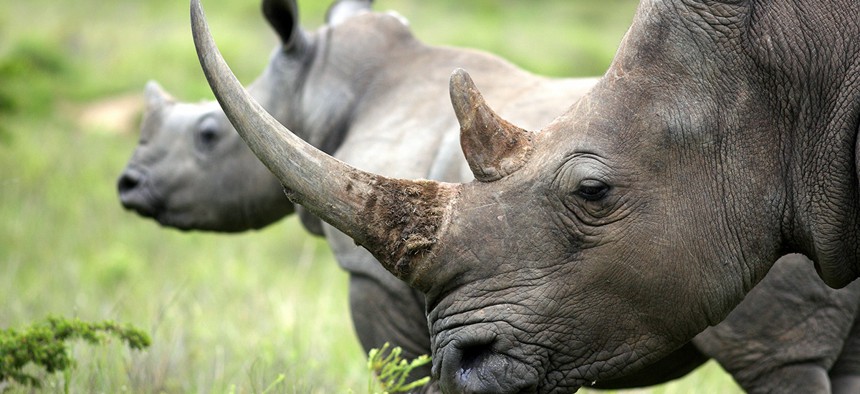3D-Printed Rhino Horns Will Be Ready in Two Years, But Will They Save the Rhinos?

JONATHAN PLEDGER/Shutterstock.com
Africa’s wild rhinos are in danger of going extinct within the next two decades if demand for their horns keeps up.
Africa’s wild rhinos are in danger of going extinct within the next two decades if demand for their horns keeps up. Proposed solutions have ranged from harvesting the horns without killing the animal to legalizing the trade, banned since the 1970s, to reduce the size of the black market.
There may soon be a third option to meet demand, mostly in Asia where the horns are part of traditional medicine, offered as gifts and used as decorative status symbols. Pembient, one of a handful of biotech firms around the world that are working on synthetic imitations of rhino horns, has said its product will be ready in two years.
“Earlier this year, we produced low fidelity prototypes, they are solids but they don’t have all the properties of rhino horn and we are working now to produce these high quality bio-identical solids,” Matthew Markus, chief executive of the Seattle-based company, told the BBC.
Others working on rhino horn prototypes include Cerato Tech, Rhinoceros Horn LLC, and a startup called Stop Rhino Poaching Through Synthetic Rhino Horns.
Pembient is perhaps the furthest along. Last year, Markus told Quartz that the company had produced a dried powder out of keratin and rhino DNA that can be 3D-printed into solid material and is genetically identical to horns from the animal. Markus believes that selling artificial horns will curb demand for the real thing.
In South Africa, which has the world’s largest population of rhinos, poaching has spiked in the past decade, reaching a record high of 1,215 rhinos killed in 2014. Poaching has abated slightly with 1,175 rhinos killed last year. As of May this year, South Africa had recorded 363 poaching incidents.
“We believe we can [produce a synthetic horn] at one-eighth of the price,” Markus told Quartz. Real rhino horn can fetch up to $60,000 a kilogram (about $27,000 per pound).
The company, which plans to make a range of products with synthetic horn in them, from lotions to beer, also plans to use its technology to replicate other parts of endangered animals, like elephant tusks or the scales of pangolins—the world’s most trafficked animal. Last week a meeting of the Convention on International Trade in Endangered Species gave pangolins “Appendix I” status, the highest level of protection, which bans almost all commercial trade in them.
Still, environmental groups are critical of Pembient and its rivals. Earlier this year, the Center for Biological Diversity, a US-based nonprofit, filed a petition with the US Fish and Wildlife Service to ban the sale of cultured horns. The group argues that instead of reducing demand they will, by reaching more customers, widen the appeal of rhino horn.
The trade could also provide cover for trafficking genuine horns, they argue. Moreover, selling rhino-infused medicine, beer, and lotion, even if synthetic, lends credence to the unproven belief that these horns have health benefits.
Sarah Uhlemann, senior attorney for the the nonprofit, said, “What does that say to the public? How can a consumer know what to believe? It creates incredible consumer confusion.”
NEXT STORY: A Mechanic Faces the Age of the Self-Driving Car






